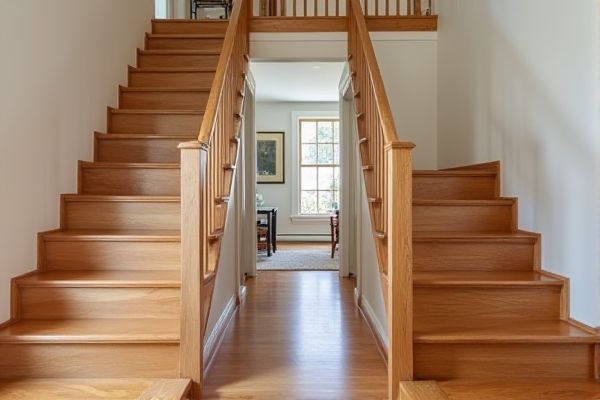
Maple stairs offer a light, durable surface with a tight grain ideal for high-traffic areas, while walnut stairs provide a rich, dark finish that adds warmth and elegance to any interior. Discover which hardwood suits your style and needs best by exploring the rest of this article.
Table of Comparison
| Feature | Maple Stairs | Walnut Stairs |
|---|---|---|
| Wood Type | Hardwood, light-colored | Hardwood, rich dark brown |
| Durability | Highly durable, resistant to wear | Durable, but slightly softer than maple |
| Grain Pattern | Fine, smooth grain | Distinct, wavy grain |
| Appearance | Light, clean look, modern appeal | Warm, luxurious, classic appeal |
| Cost | Generally more affordable | Typically higher price due to luxury status |
| Maintenance | Easy to maintain, can be sanded and refinished | Requires regular care, refinishing may be needed |
| Best Use | Modern, bright interiors; high-traffic areas | Traditional, elegant interiors; statement staircases |
Introduction to Maple and Walnut Stairs
Maple stairs offer a light, uniform grain with exceptional durability, making them ideal for high-traffic areas requiring long-lasting beauty. Walnut stairs feature a rich, dark color and striking grain patterns that bring warmth and elegance to your home's interior. Choosing between maple and walnut stairs depends on your style preference and desired flooring resilience.
Visual Appeal: Maple vs Walnut
Maple stairs offer a clean, light-toned appearance with subtle grain patterns that brighten spaces and complement modern interiors. Walnut stairs provide a rich, dark, and warm aesthetic with pronounced grain textures, adding elegance and depth to traditional or sophisticated designs. Your choice between maple and walnut stairs influences the overall ambiance, balancing brightness with warmth and understated versus bold visual appeal.
Durability and Longevity Comparison
Maple stairs exhibit exceptional hardness and resistance to wear, making them highly durable for high-traffic areas. Walnut stairs, while slightly softer, offer impressive longevity due to their density and natural oils that resist decay and insect damage. Your choice between maple and walnut stairs should consider the specific durability needs and maintenance preferences for lasting performance.
Color and Grain Differences
Maple stairs feature a lighter color palette, ranging from creamy white to light golden hues, with a subtle, fine grain that provides a smooth and uniform appearance. Walnut stairs exhibit deeper, richer tones, from chocolate brown to purplish-black, with a pronounced, wavy grain pattern that adds bold texture and visual interest. Choosing between maple and walnut stairs depends on desired contrast, as maple offers brightness while walnut brings warmth and dramatic grain variation.
Cost Analysis: Maple vs Walnut Stairs
Maple stairs typically cost less than walnut stairs due to the abundance and faster growth rate of maple trees, making maple a budget-friendly option for staircase construction. Walnut, known for its rich color and durability, commands a higher price that reflects its premium status and aesthetic appeal. Your choice between maple and walnut stairs will significantly impact your project's budget, with maple offering cost savings and walnut providing a high-end, luxurious finish.
Maintenance and Cleaning Requirements
Maple stairs require regular dusting and mild soap with water for cleaning to preserve their bright, light finish and resist wear, while walnut stairs benefit from gentle cleaning to maintain their rich, dark tones and natural oils. Both types demand protective measures such as using mats or pads to prevent scratches and periodic refinishing to extend their lifespan. Your choice between maple and walnut stairs will influence the frequency and type of maintenance needed to keep them looking pristine.
Installation Considerations
Maple stairs require precise moisture control during installation due to their tendency to expand and contract, which can affect the fit and finish of your staircase. Walnut stairs offer easier installation with better dimensional stability, minimizing the risk of gaps and warping over time. Choosing the right species based on your environment ensures a smoother installation process and long-lasting durability.
Environmental Sustainability
Maple stairs offer a more environmentally sustainable choice due to their faster growth rate and higher availability, which reduces deforestation pressure compared to walnut stairs. Walnut is a slower-growing hardwood, often sourced from limited or old-growth forests, making it less eco-friendly and sometimes subject to stricter harvesting regulations. Choosing maple stairs supports responsible forestry practices and helps minimize your overall environmental footprint.
Best Uses for Maple Stairs
Maple stairs are ideal for high-traffic areas such as commercial buildings and busy homes due to their exceptional hardness and resistance to wear. Their fine, consistent grain provides a smooth surface that is perfect for modern, sleek stair designs in both residential and office settings. Maple's light, natural color also allows for versatile finishing options, making it a popular choice for creating bright, contemporary staircases.
Best Uses for Walnut Stairs
Walnut stairs excel in high-end residential and commercial spaces where durability and rich aesthetics are prioritized, offering a deep, warm tone that complements sophisticated interiors. You will find walnut ideal for areas requiring strong wear resistance combined with elegant grain patterns, such as grand entrances and formal living rooms. Its natural resilience to dents and scratches makes walnut stairs a practical choice for homes with heavy foot traffic while maintaining a luxurious appearance.
 homyna.com
homyna.com